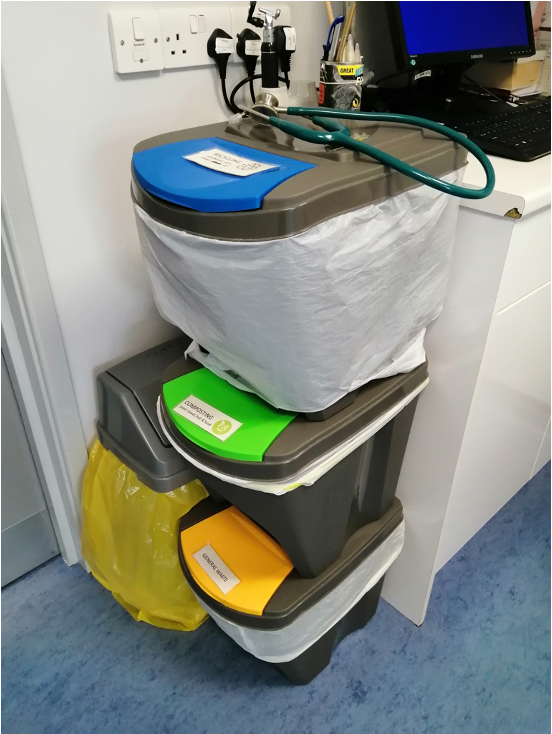Simpler Workplace Waste: England’s New Recycling Regulations
From 31st March 2025 new workplace recycling regulations will come into effect for businesses and non-domestic premises across England. Take a look at our summary to find out more information about what you will be required to do.
Vet Sustain
From 31st March (or 31 March 2027 for micro-firms with less than 10 full time employees) workplaces that generate waste similar in nature and composition to household waste have a legal duty to present waste separated into 3 categories:
- Dry recyclable materials – plastic, metal, glass, paper and card
Waste collectors may require for paper and card, and glass to be separated from other dry recyclables (plastic and metal)
Food waste – food leftovers and waste generated by the preparation of food - this can include leftover pet food (provided it is not contaminated with medications)
Black bin waste (residual waste) – absorbent hygiene products such as nappies, highly contaminated materials like food packaging that cannot be washed
Garden waste must be managed in accordance with the waste hierarchy (as shown in Figure 1), arranging for it to be recycled or composted if it delivers the best environmental outcome.

Figure 1: The Waste Hierarchy from Keep Britain Tidy (2024)
Waste collectors will provide appropriate size of containers and frequency of collections based on the needs of the premises and volume of waste they produce.
Finding a waste collector – You can use a private waste collector, or your local authority. If using a private waste collector, you must arrange separate collections of dry recycling, food waste and black bin waste. If your provider does not offer the full range of collection services, you will need to arrange these from other providers. All private waste collection services must be registered on the public register of waste carriers, brokers and dealers.
If you do not comply with these requirements by 31st March 2025 (or 31st March 2027 for micro-firms), you are at risk of receiving a compliance notice from the Environment Agency.
What does this look like in practice?
Having the right recycling collections in place is obviously important, but getting people to put the right things in the right bins can be challenging! Having a clear waste/recycling system in practice will help with adherence to these new rules. Check out our 5 top tips for practical actions you can take in practice:
1) Conduct a Waste Audit
A first step could be a waste audit - it’s worth getting in touch with your waste collector to see if this is a service that they offer. They will come and audit your current bins, check for contamination, and advise you if you need any changes to the numbers and types of bins.
If this service isn’t available, and you’re super keen, see if you can recruit a buddy or two to don a pair of rubber gloves and go bin diving! This can be a useful exercise to identify any problems with waste segregation, and photographic evidence can be a good motivator for colleagues! WRAP’s new ‘Business of Recycling’ website has created this resource for conducting waste audits in healthcare settings.
2) Colour Code Your Bins
Different colour bins for different bins can be helpful, and keeping the same system and layout in each room/area will also help. Helen Gould, at Old Hall Vets in Cumbria has stackable bins with different colour lids, and clear labelling on each bin (as shown in Image 1). There is also a laminated poster by the computer in each consult room/area which details what can go into each bin. New starters get shown the recycling system which really helps them to quickly get on board with the practice’s recycling protocols.

Image 1: Stackable bins with coloured lids (Image courtesy of Helen Gould, Old Hall Vets, Cumbria).
3) Optimise Bin Location
Think about where you need different bins - food waste bins will probably only be needed in the staff room and possibly the wards. As long as pet food hasn’t had any medications added, it should be fine to go in your food waste collection, but do check with your waste collection provider if you’re unsure.
4) Ensure Bins Are Clearly Labelled
Clear labelling is important - using icons as well as words can improve segregation and reduce contamination. If there is potential for confusion, be really specific eg on your paper and cardboard bin, state NO BLUE TOWEL/PAPER TISSUES.
5) Set Targets and Talk to Staff
Set targets to improve recycling rates and communicate these to staff. If you have branch practices, this can be ‘gamified’ and made into a competition, which might encourage people to get on board!
More information on the new workplace recycling regulations can be found using the following link - https://www.gov.uk/guidance/simpler-recycling-workplace-recycling-in-england.
For further information, take a look at WRAP’s Business of Recycling website which is packed with resources.
There is specific guidance for healthcare settings here, which can be useful as a guide for the veterinary sector.
And some really useful posters for bin labelling here.
References:
Keep Britain Tidy (2024) Keep Britain Tidy unveils new waste hierarchy to encourage reduce and reuse behaviours [online]. Available from: https://www.keepbritaintidy.org/news/keep-britain-tidy-unveils-new-waste-hierarchy-encourage-reduce-and-reuse-behaviours. Accessed 28/03/2025